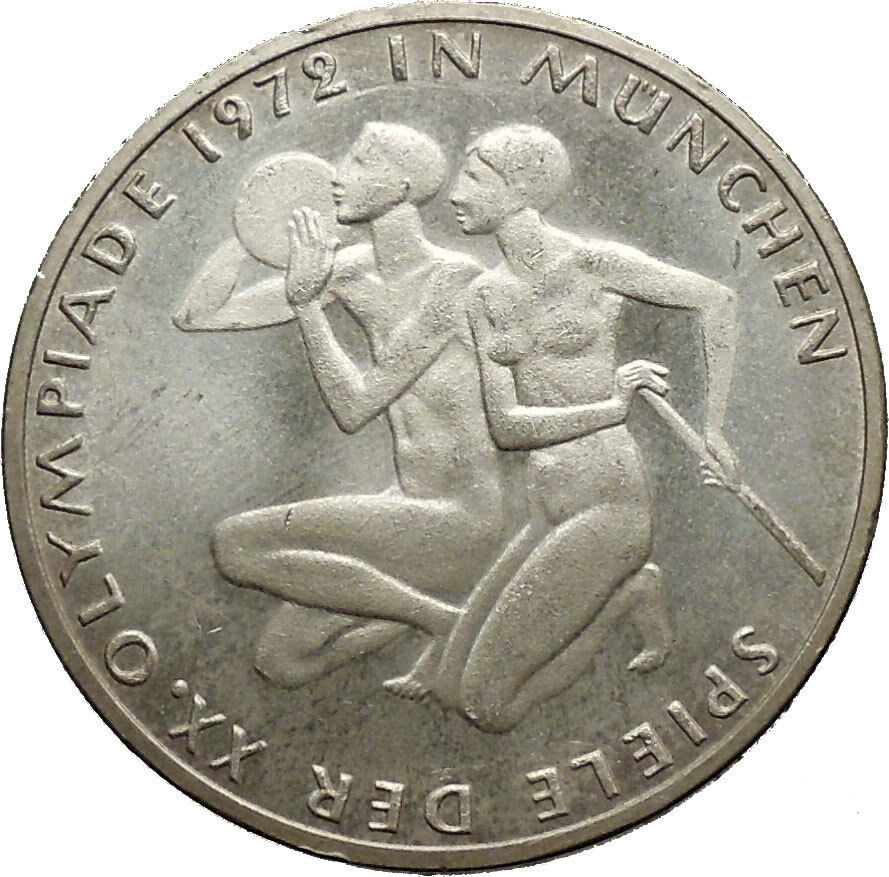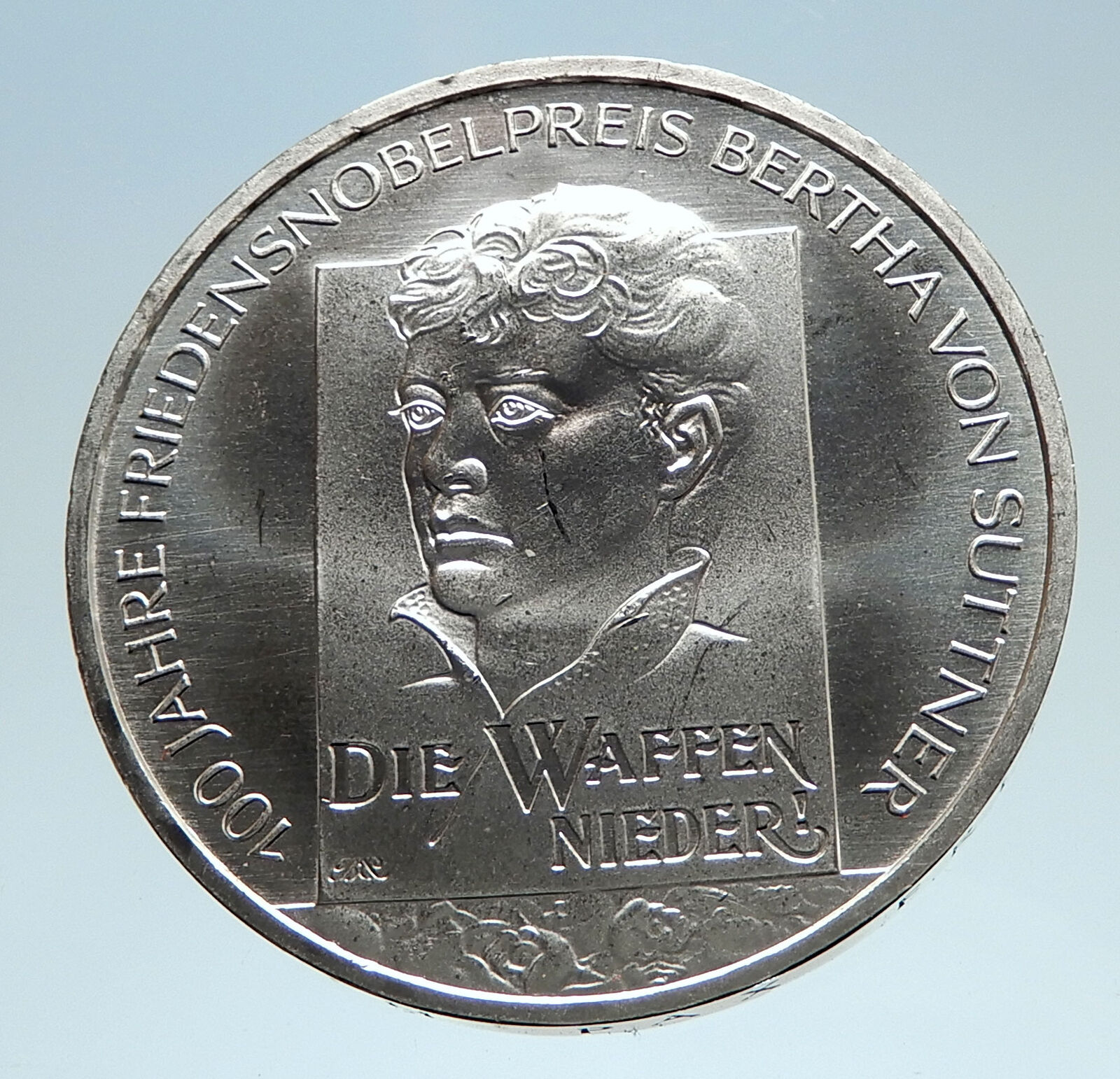|
Germany – 300th Anniversary – Death of Hans Jakob Christian von Grimmelshausen
1976 D Proof Silver 5 Marks 29mm (11.20 grams) 0.625 Silver (0.2251 oz. ASW)
Reference: KM# 144
BUNDESREPUBLIK DEUTSCHLAND 5 DEUTSCHE MARK 1976 D, An eagle, emblem of Germany.
HANS JACOB CHRISTOPH VON GRIMMELSHAUSEN 1621* 1676+, Allegory based on Hans Jakob Christoffel von Grimmelshausen main piece, Der abenteuerliche Simplicissimus, the greatest German novel from the 17th century.
Edge Lettering:
DER ABENTHEURLICHE SIMPLICISSIMUS
You are bidding on the exact item pictured, provided with a Certificate of Authenticity and Lifetime Guarantee of Authenticity.
 Hans Jakob Christoffel von Grimmelshausen (1621/22 – 17 August 1676) was a German author. He is best known for his 1669 picaresque novel Simplicius Simplicissimus (German: Der abentheurliche Simplicissimus) and the accompanying Simplician Scriptures series. Hans Jakob Christoffel von Grimmelshausen (1621/22 – 17 August 1676) was a German author. He is best known for his 1669 picaresque novel Simplicius Simplicissimus (German: Der abentheurliche Simplicissimus) and the accompanying Simplician Scriptures series.
Early life
Grimmelshausen was born at Gelnhausen. At the age of ten he was kidnapped by Hessian soldiery, and in their midst experienced military life in the Thirty Years’ War. At the close of the war, Grimmelshausen entered the service of Franz Egon von Fürstenberg, bishop of Strasbourg. In 1665, he was made magistrate (German: Schultheiss) at Renchen in Baden. On obtaining this appointment, he devoted himself to literary pursuits.
Works
Grimmelshausen’s work is greatly influenced by previous utopian and travel literature, and the Simplicissimus series attained a readership larger than any other seventeenth-century novel. Formerly, he was credited with Der fliegende Wandersmann nach dem Mond, a translation from Jean Baudoin’s L’Homme dans la Lune, itself a translation of Francis Godwin’s The Man in the Moone, but recent scholars have denied this; he did, however, write an appendix to a 1667 edition of that translation, the basis for that association. Der fliegende Wandersman was included in his collected works, though without the appendix.
In 1668, Grimmelshausen published Der abentheurliche Simplicissimus, which has been called the greatest German novel of the 17th century. For this work he took as his model the picaresque romances of Spain, already to some extent known in Germany. Simplicissimus has been interpreted as its author’s autobiography; he begins with the childhood of his hero, and describes the latter’s adventures amid the stirring scenes of the Thirty Years’ War. The rustic detail with which these pictures are presented makes the book a valuable document of its time. For some, however, the later parts of the book overindulge in allegory, and finally become a Robinson Crusoe story.
The historian Robert Ergang draws upon Gustav Könnecke’s Quellen und Forschungen zur Lebensgeschichte Grimmelshausens to assert that “the events related in the novel Simplicissimus could hardly have been autobiographical since [Grimmelshausen] lived a peaceful existence in quiet towns and villages on the fringe of the Black Forest and that the material he incorporated in his work was not taken from actual experience, but was either borrowed from the past, collected from hearsay, or created by a vivid imagination.”
Among Grimmelshausen’s other works, are the so-called Simplicianische Schriften (German: Simplizianische Schriften):
- Die Ertzbetrügerin and Landstörtzerin Courasche (1670)
- Der seltsame Springinsfeld (1670)
- Das wunderbarliche Vogelnest (1672)
He also published satires, such as Der teutsche Michel (1673), and gallant novels, like Dietwald und Amelinde (1670).
Death and legacy
He died in Renchen in 1676, where a monument was erected to him in 1879.
Grimmelshausen’s Landstörtzerin Courasche became an inspiration for Bertolt Brecht’s play Mother Courage and Her Children.
Der abenteuerliche Simplicissimus lent its name to Simplicissimus, a satirical German weekly which ran from 1894-1944 and 1954-67.
 Germany, officially the Federal Republic of Germany, officially the Federal Republic of  Germany is a federal parliamentary republic in western-central Europe. It includes 16 constituent states and covers an area of 357,021 square kilometres (137,847 sq mi) with a largely temperate seasonal climate. Its capital and largest city is Berlin. With 81 million inhabitants, Germany is the most populous member state in the European Union. After the United States, it is the second most popular migration destination in the world. Germany is a federal parliamentary republic in western-central Europe. It includes 16 constituent states and covers an area of 357,021 square kilometres (137,847 sq mi) with a largely temperate seasonal climate. Its capital and largest city is Berlin. With 81 million inhabitants, Germany is the most populous member state in the European Union. After the United States, it is the second most popular migration destination in the world.
Various Germanic tribes have occupied northern Germany since classical antiquity. A region named Germania was documented before 100 CE. During the Migration Period the Germanic tribes expanded southward. Beginning in the 10th century, German territories formed a central part of the Holy Roman Empire. During the 16th century, northern German regions became the centre of the Protestant Reformation.
The rise of Pan-Germanism inside the German Confederation resulted in the unification of most of the German states in 1871 into the Prussian-dominated German Empire. After World War I and the German Revolution of 1918-1919, the Empire was replaced by the parliamentary Weimar Republic. The establishment of the Third Reich in 1933 led to World War II and the Holocaust. After 1945, Germany split into two states, East Germany and West Germany. In 1990, the country was reunified.
 In the 21st century, Germany is a great power and has the world’s fourth-largest economy by nominal GDP, as well as the fifth-largest by PPP. As a global leader in several industrial and technological sectors, it is both the world’s third-largest exporter and importer of goods. Germany is a developed country with a very high standard of living sustained by a skilled and productive society. It upholds a social security and universal health care system, environmental protection and a tuition free university education. In the 21st century, Germany is a great power and has the world’s fourth-largest economy by nominal GDP, as well as the fifth-largest by PPP. As a global leader in several industrial and technological sectors, it is both the world’s third-largest exporter and importer of goods. Germany is a developed country with a very high standard of living sustained by a skilled and productive society. It upholds a social security and universal health care system, environmental protection and a tuition free university education.
Germany was a founding member of the European Union in 1993. It is part of the Schengen Area, and became a co-founder of the Eurozone in 1999. Germany is a member of the United Nations, NATO, the G8, the G20, and the OECD. The national military expenditure is the 9th highest in the world. Known for its rich cultural history, Germany has been continuously the home of influential artists, philosophers, musicians, sportsmen, entrepreneurs, scientists and inventors.
|





 Hans Jakob Christoffel von Grimmelshausen (1621/22 – 17 August 1676) was a German author. He is best known for his 1669 picaresque novel Simplicius Simplicissimus (German: Der abentheurliche Simplicissimus) and the accompanying Simplician Scriptures series.
Hans Jakob Christoffel von Grimmelshausen (1621/22 – 17 August 1676) was a German author. He is best known for his 1669 picaresque novel Simplicius Simplicissimus (German: Der abentheurliche Simplicissimus) and the accompanying Simplician Scriptures series.  Germany, officially the Federal Republic of
Germany, officially the Federal Republic of  Germany is a federal parliamentary republic in western-central Europe. It includes 16 constituent states and covers an area of 357,021 square kilometres (137,847 sq mi) with a largely temperate seasonal climate. Its capital and largest city is Berlin. With 81 million inhabitants, Germany is the most populous member state in the European Union. After the United States, it is the second most popular migration destination in the world.
Germany is a federal parliamentary republic in western-central Europe. It includes 16 constituent states and covers an area of 357,021 square kilometres (137,847 sq mi) with a largely temperate seasonal climate. Its capital and largest city is Berlin. With 81 million inhabitants, Germany is the most populous member state in the European Union. After the United States, it is the second most popular migration destination in the world. In the 21st century, Germany is a great power and has the world’s fourth-largest economy by nominal GDP, as well as the fifth-largest by PPP. As a global leader in several industrial and technological sectors, it is both the world’s third-largest exporter and importer of goods. Germany is a developed country with a very high standard of living sustained by a skilled and productive society. It upholds a social security and universal health care system, environmental protection and a tuition free university education.
In the 21st century, Germany is a great power and has the world’s fourth-largest economy by nominal GDP, as well as the fifth-largest by PPP. As a global leader in several industrial and technological sectors, it is both the world’s third-largest exporter and importer of goods. Germany is a developed country with a very high standard of living sustained by a skilled and productive society. It upholds a social security and universal health care system, environmental protection and a tuition free university education.




